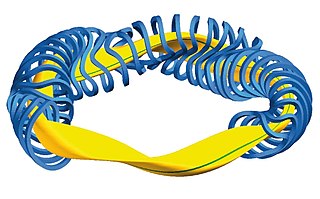
A stellarator is a device that confines plasma using external magnets. Scientists researching magnetic confinement fusion aim to use stellarator devices as a vessel for nuclear fusion reactions. The name refers to stars as fusion also occurs in stars such as the Sun. It is one of the earliest fusion power devices, along with the z-pinch and magnetic mirror.

A tokamak is a device which uses a powerful magnetic field generated by external magnets to confine plasma in the shape of an axially-symmetrical torus. The tokamak is one of several types of magnetic confinement devices being developed to produce controlled thermonuclear fusion power. The tokamak concept is currently one of the leading candidates for a practical fusion reactor.

In plasma physics, plasma stability concerns the stability properties of a plasma in equilibrium and its behavior under small perturbations. The stability of the system determines if the perturbations will grow, oscillate, or be damped out. It is an important consideration in topics such as nuclear fusion and astrophysical plasma.

The Large Helical Device (LHD) is a fusion research device located in Toki, Gifu, Japan. It is operated by the National Institute for Fusion Science, and is the world's second-largest superconducting stellarator, after Wendelstein 7-X. The LHD employs a heliotron magnetic field originally developed in Japan.

Magnetic confinement fusion (MCF) is an approach to generate thermonuclear fusion power that uses magnetic fields to confine fusion fuel in the form of a plasma. Magnetic confinement is one of two major branches of controlled fusion research, along with inertial confinement fusion.
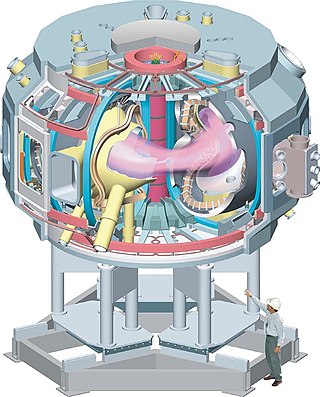
The National Compact Stellarator Experiment, NCSX in short, was a magnetic fusion energy experiment based on the stellarator design being constructed at the Princeton Plasma Physics Laboratory (PPPL).

The Wendelstein 7-X reactor is an experimental stellarator built in Greifswald, Germany, by the Max Planck Institute for Plasma Physics (IPP), and completed in October 2015. Its purpose is to advance stellarator technology: though this experimental reactor will not produce electricity, it is used to evaluate the main components of a future fusion power plant; it was developed based on the predecessor Wendelstein 7-AS experimental reactor.

The Helically Symmetric Experiment, is an experimental plasma confinement device at the University of Wisconsin–Madison, with design principles that are intended to be incorporated into a fusion reactor. The HSX is a modular coil stellarator which is a toroid-shaped pressure vessel with external electromagnets which generate a magnetic field for the purpose of containing a plasma. It began operation in 1999.
The Columbia Non-neutral Torus (CNT) is a small stellarator at the Columbia University Plasma Physics Laboratory designed by Thomas Sunn Pedersen with the aid of Wayne Reiersen and Fred Dahlgren of the Princeton Plasma Physics Laboratory to conduct the first investigation of non-neutral plasmas confined on magnetic surfaces. The experiment, which began operation in November 2004, is funded by the National Science Foundation and the United States Department of Energy in the form of a Faculty Early Career Development (CAREER) award.
Magneto-inertial fusion (MIF) describes a class of fusion devices which combine aspects of magnetic confinement fusion and inertial confinement fusion in an attempt to lower the cost of fusion devices. MIF uses magnetic fields to confine an initial warm, low-density plasma, then compresses that plasma to fusion conditions using an impulsive driver or "liner."
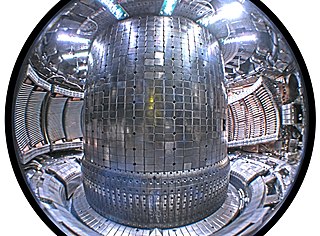
In magnetic confinement fusion, a divertor or diverted configuration is a magnetic field configuration of a tokamak or a stellarator which separates the confined plasma from the material surface of the device. The plasma particles which diffuse across the boundary of the confined region are diverted by the open, wall-intersecting magnetic field lines to wall structures which are called the divertor targets, usually remote from the confined plasma. The magnetic divertor extracts heat and ash produced by the fusion reaction, minimizes plasma contamination, and protects the surrounding walls from thermal and neutronic loads.
The GLAss Spherical Tokamak is a name given to a set of small spherical tokamaks located in Islamabad, Pakistan. They were developed by the Pakistan Atomic Energy Commission (PAEC) as part of the National Tokamak Fusion Program (NTFP) in 2008 and are primarily used for teaching and training purposes.
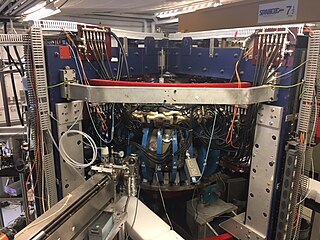
The Hybrid Illinois Device for Research and Applications (HIDRA) is a medium-sized toroidal magnetic fusion device housed in the Nuclear Radiation Laboratory and operated by the Center for Plasma-Material Interactions (CPMI) within the Department of Nuclear, Plasma and Radiological Engineering at the University of Illinois at Urbana–Champaign, United States. HIDRA had its first plasma at the end of April 2016 and started experimental campaigns by December of that year. HIDRA is the former WEGA classical stellarator that was operated at the Max Planck Institute for Plasma Physics in Greifswald Germany from 2001 to 2013.

Víctor Iván Vargas Blanco is Costa Rican plasma and nuclear fusion physicist. He is renowned for his work in plasma physics and nuclear fusion. Currently, as a professor and tenured researcher at the Costa Rica Institute of Technology, he heads the Plasma Laboratory for Fusion Energy and Applications that he founded in 2011.

The Compact Toroidal Hybrid (CTH) is an experimental device at Auburn University that uses magnetic fields to confine high-temperature plasmas. CTH is a torsatron type of stellarator with an external, continuously wound helical coil that generates the bulk of the magnetic field for containing a plasma.
Jürgen Nührenberg is a German plasma physicist.
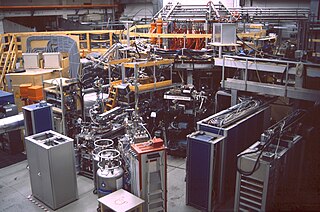
Wendelstein 7-AS was an experimental stellarator which was in operation from 1988 to 2002 by the Max Planck Institute for Plasma Physics (IPP) in Garching. It was the first of a new class of advanced stellarators with modular coils, designed with the goal of developing a nuclear fusion reactor to generate electricity.

The Tokamak Chauffage Alfvén Brésilien (TCABR) is a tokamak situated at the University of Sao Paulo (USP), Brazil. TCABR is the largest tokamak in the southern hemisphere and one of the magnetic-confinement devices committed to advancing scientific knowledge in fusion power.

Omnigeneity is a property of a magnetic field inside a magnetic confinement fusion reactor. Such a magnetic field is called omnigenous if the path a single particle takes does not drift radially inwards or outwards on average. A particle is then confined to stay on a flux surface. All tokamaks are exactly omnigenous by virtue of their axisymmetry, and conversely an unoptimized stellarator is generally not omnigenous.














